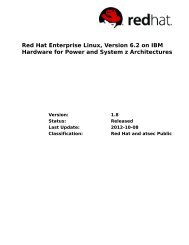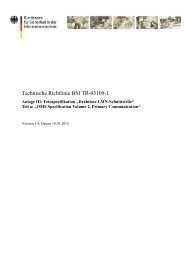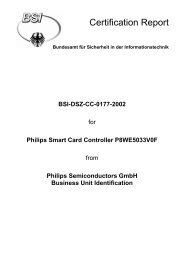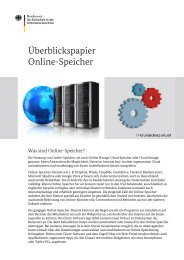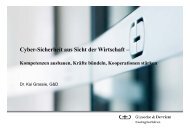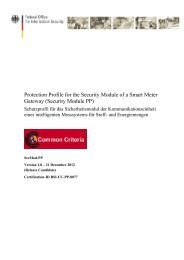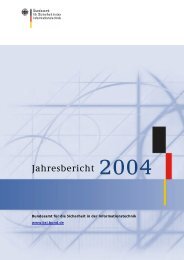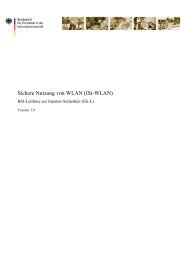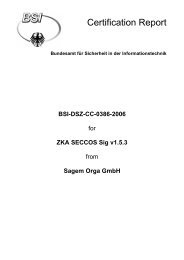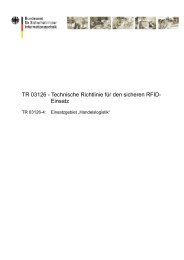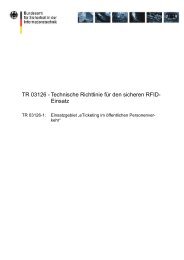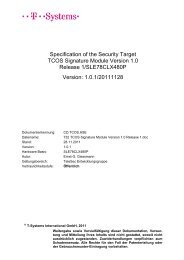Certification Report BSI-DSZ-CC-0769-2012 - Bundesamt für ...
Certification Report BSI-DSZ-CC-0769-2012 - Bundesamt für ...
Certification Report BSI-DSZ-CC-0769-2012 - Bundesamt für ...
Create successful ePaper yourself
Turn your PDF publications into a flip-book with our unique Google optimized e-Paper software.
<strong>BSI</strong>-<strong>DSZ</strong>-<strong>CC</strong>-<strong>0769</strong>-<strong>2012</strong><br />
for<br />
STARCOS 3.5 ID E<strong>CC</strong> C1<br />
from<br />
Giesecke & Devrient GmbH
<strong>BSI</strong> - <strong>Bundesamt</strong> <strong>für</strong> Sicherheit in der Informationstechnik, Postfach 20 03 63, D-53133 Bonn<br />
Phone +49 (0)228 99 9582-0, Fax +49 (0)228 9582-5477, Infoline +49 (0)228 99 9582-111<br />
<strong>Certification</strong> <strong>Report</strong> V1.0 <strong>CC</strong>-Zert-327 V4.64
<strong>BSI</strong>-<strong>DSZ</strong>-<strong>CC</strong>-<strong>0769</strong>-<strong>2012</strong><br />
Secure Signature Creation Device (SSCD)<br />
STARCOS 3.5 ID E<strong>CC</strong> C1<br />
from Giesecke & Devrient GmbH<br />
PP Conformance: Protection Profile for Secure Signature Creation<br />
Device - Part 2: Device with Key Generation,<br />
Dezember 2009, <strong>BSI</strong>-<strong>CC</strong>-PP-0059-2009<br />
Functionality: PP conformant plus product specific extensions<br />
Common Criteria Part 2 extended<br />
Assurance: Common Criteria Part 3 conformant<br />
EAL 4 augmented by AVA_VAN.5<br />
Common Criteria<br />
Recognition<br />
Arrangement<br />
for components up to<br />
EAL 4<br />
The IT product identified in this certificate has been evaluated at an approved evaluation facility using the<br />
Common Methodology for IT Security Evaluation (CEM), Version 3.1 extended by advice of the <strong>Certification</strong><br />
Body for components beyond EAL 5 and guidance specific for the technology of the product for conformance<br />
to the Common Criteria for IT Security Evaluation (<strong>CC</strong>), Version 3.1.<br />
This certificate applies only to the specific version and release of the product in its evaluated configuration<br />
and in conjunction with the complete <strong>Certification</strong> <strong>Report</strong>.<br />
The evaluation has been conducted in accordance with the provisions of the certification scheme of the<br />
German Federal Office for Information Security (<strong>BSI</strong>) and the conclusions of the evaluation facility in the<br />
evaluation technical report are consistent with the evidence adduced.<br />
This certificate is not an endorsement of the IT product by the Federal Office for Information Security or any<br />
other organisation that recognises or gives effect to this certificate, and no warranty of the IT product by the<br />
Federal Office for Information Security or any other organisation that recognises or gives effect to this<br />
certificate, is either expressed or implied.<br />
Bonn, 31 August <strong>2012</strong><br />
For the Federal Office for Information Security<br />
Bernd Kowalski L.S.<br />
Head of Department<br />
<strong>Bundesamt</strong> <strong>für</strong> Sicherheit in der Informationstechnik<br />
Godesberger Allee 185-189 - D-53175 Bonn - Postfach 20 03 63 - D-53133 Bonn<br />
Phone +49 (0)228 99 9582-0 - Fax +49 (0)228 9582-5477 - Infoline +49 (0)228 99 9582-111<br />
for components up<br />
to EAL 4
<strong>Certification</strong> <strong>Report</strong> <strong>BSI</strong>-<strong>DSZ</strong>-<strong>CC</strong>-<strong>0769</strong>-<strong>2012</strong><br />
4 / 40<br />
This page is intentionally left blank.
<strong>BSI</strong>-<strong>DSZ</strong>-<strong>CC</strong>-<strong>0769</strong>-<strong>2012</strong> <strong>Certification</strong> <strong>Report</strong><br />
Preliminary Remarks<br />
Under the <strong>BSI</strong>G 1 Act, the Federal Office for Information Security (<strong>BSI</strong>) has the task of<br />
issuing certificates for information technology products.<br />
<strong>Certification</strong> of a product is carried out on the instigation of the vendor or a distributor,<br />
hereinafter called the sponsor.<br />
A part of the procedure is the technical examination (evaluation) of the product according<br />
to the security criteria published by the <strong>BSI</strong> or generally recognised security criteria.<br />
The evaluation is normally carried out by an evaluation facility recognised by the <strong>BSI</strong> or by<br />
<strong>BSI</strong> itself.<br />
The result of the certification procedure is the present <strong>Certification</strong> <strong>Report</strong>. This report<br />
contains among others the certificate (summarised assessment) and the detailed<br />
<strong>Certification</strong> Results.<br />
The <strong>Certification</strong> Results contain the technical description of the security functionality of<br />
the certified product, the details of the evaluation (strength and weaknesses) and<br />
instructions for the user.<br />
1 Act on the Federal Office for Information Security (<strong>BSI</strong>-Gesetz - <strong>BSI</strong>G) of 14 August 2009,<br />
5 / 40<br />
Bundesgesetzblatt I p. 2821
<strong>Certification</strong> <strong>Report</strong> <strong>BSI</strong>-<strong>DSZ</strong>-<strong>CC</strong>-<strong>0769</strong>-<strong>2012</strong><br />
Contents<br />
A <strong>Certification</strong>........................................................................................................................7<br />
1 Specifications of the <strong>Certification</strong> Procedure.................................................................7<br />
2 Recognition Agreements................................................................................................7<br />
2.1 European Recognition of ITSEC/<strong>CC</strong> – Certificates (SOGIS-MRA).........................7<br />
2.2 International Recognition of <strong>CC</strong> – Certificates (<strong>CC</strong>RA)...........................................8<br />
3 Performance of Evaluation and <strong>Certification</strong>..................................................................8<br />
4 Validity of the <strong>Certification</strong> Result...................................................................................8<br />
5 Publication......................................................................................................................9<br />
B <strong>Certification</strong> Results.........................................................................................................11<br />
1 Executive Summary.....................................................................................................12<br />
2 Identification of the TOE...............................................................................................14<br />
3 Security Policy..............................................................................................................15<br />
4 Assumptions and Clarification of Scope.......................................................................16<br />
5 Architectural Information...............................................................................................16<br />
6 Documentation.............................................................................................................17<br />
7 IT Product Testing.........................................................................................................17<br />
8 Evaluated Configuration...............................................................................................18<br />
9 Results of the Evaluation..............................................................................................18<br />
9.1 <strong>CC</strong> specific results.................................................................................................18<br />
9.2 Results of cryptographic assessment....................................................................19<br />
10 Obligations and Notes for the Usage of the TOE.......................................................20<br />
11 Security Target............................................................................................................20<br />
12 Definitions...................................................................................................................21<br />
12.1 Acronyms.............................................................................................................21<br />
12.2 Glossary...............................................................................................................22<br />
13 Bibliography................................................................................................................23<br />
C Excerpts from the Criteria................................................................................................27<br />
D Annexes...........................................................................................................................37<br />
6 / 40
<strong>BSI</strong>-<strong>DSZ</strong>-<strong>CC</strong>-<strong>0769</strong>-<strong>2012</strong> <strong>Certification</strong> <strong>Report</strong><br />
A <strong>Certification</strong><br />
1 Specifications of the <strong>Certification</strong> Procedure<br />
The certification body conducts the procedure according to the criteria laid down in the<br />
following:<br />
● <strong>BSI</strong>G 2<br />
● <strong>BSI</strong> <strong>Certification</strong> Ordinance 3<br />
● <strong>BSI</strong> Schedule of Costs 4<br />
● Special decrees issued by the Bundesministerium des Innern (Federal Ministry of the<br />
Interior)<br />
● DIN EN 45011 standard<br />
● <strong>BSI</strong> certification: Procedural Description (<strong>BSI</strong> 7125) [3]<br />
● Common Criteria for IT Security Evaluation (<strong>CC</strong>), Version 3.1 5 [1]<br />
● Common Methodology for IT Security Evaluation, Version 3.1 [2]<br />
● <strong>BSI</strong> certification: Application Notes and Interpretation of the Scheme (AIS) [4]<br />
2 Recognition Agreements<br />
In order to avoid multiple certification of the same product in different countries a mutual<br />
recognition of IT security certificates - as far as such certificates are based on ITSEC or<br />
<strong>CC</strong> - under certain conditions was agreed.<br />
2.1 European Recognition of ITSEC/<strong>CC</strong> – Certificates (SOGIS-MRA)<br />
The SOGIS-Mutual Recognition Agreement (SOGIS-MRA) Version 3 became effective in<br />
April 2010. It defines the recognition of certificates for IT-Products at a basic recognition<br />
level and in addition at higher recognition levels for IT-Products related to certain technical<br />
domains only.<br />
The basic recognition level includes Common Criteria (<strong>CC</strong>) Evaluation Assurance Levels<br />
EAL 1 to EAL 4 and ITSEC Evaluation Assurance Levels E1 to E3 (basic). For higher<br />
recognition levels the technical domain Smart card and similar Devices has been defined.<br />
It includes assurance levels beyond EAL 4 resp. E3 (basic). In addition, certificates issued<br />
for Protection Profiles based on Common Criteria are part of the recognition agreement.<br />
2 Act on the Federal Office for Information Security (<strong>BSI</strong>-Gesetz - <strong>BSI</strong>G) of 14 August 2009,<br />
Bundesgesetzblatt I p. 2821<br />
3 Ordinance on the Procedure for Issuance of a Certificate by the Federal Office for Information Security<br />
(<strong>BSI</strong>-Zertifizierungsverordnung, <strong>BSI</strong>ZertV) of 07 July 1992, Bundesgesetzblatt I p. 1230<br />
4 Schedule of Cost for Official Procedures of the <strong>Bundesamt</strong> <strong>für</strong> Sicherheit in der Informationstechnik<br />
(<strong>BSI</strong>-Kostenverordnung, <strong>BSI</strong>-KostV) of 03 March 2005, Bundesgesetzblatt I p. 519<br />
5 Proclamation of the Bundesministerium des Innern of 12 February 2007 in the Bundesanzeiger dated<br />
7 / 40<br />
23 February 2007, p. 3730
<strong>Certification</strong> <strong>Report</strong> <strong>BSI</strong>-<strong>DSZ</strong>-<strong>CC</strong>-<strong>0769</strong>-<strong>2012</strong><br />
As of September 2011 the new agreement has been signed by the national bodies of<br />
Austria, Finland, France, Germany, Italy, The Netherlands, Norway, Spain, Sweden and<br />
the United Kingdom.Details on recognition and the history of the agreement can be found<br />
at https://www.bsi.bund.de/zertifizierung.<br />
The SOGIS-MRA logo printed on the certificate indicates that it is recognised under the<br />
terms of this agreement by the nations listed above.<br />
2.2 International Recognition of <strong>CC</strong> – Certificates (<strong>CC</strong>RA)<br />
An arrangement (Common Criteria Recognition Arrangement) on the mutual recognition of<br />
certificates based on the <strong>CC</strong> Evaluation Assurance Levels up to and including EAL 4 has<br />
been signed in May 2000 (<strong>CC</strong>RA). It includes also the recognition of Protection Profiles<br />
based on the <strong>CC</strong>.<br />
As of September 2011 the arrangement has been signed by the national bodies of:<br />
Australia, Austria, Canada, Czech Republic, Denmark, Finland, France, Germany, Greece,<br />
Hungary, India, Israel, Italy, Japan, Republic of Korea, Malaysia, The Netherlands, New<br />
Zealand, Norway, Pakistan, Republic of Singapore, Spain, Sweden, Turkey, United<br />
Kingdom, United States of America. The current list of signatory nations and approved<br />
certification schemes can be seen on the website: http://www.commoncriteriaportal.org.<br />
The Common Criteria Recognition Arrangement logo printed on the certificate indicates<br />
that this certification is recognised under the terms of this agreement by the nations listed<br />
above.<br />
This evaluation contains the component AVA_VAN.5 that is not mutually recognised in<br />
accordance with the provisions of the <strong>CC</strong>RA. For mutual recognition the EAL 4<br />
components of these assurance families are relevant.<br />
3 Performance of Evaluation and <strong>Certification</strong><br />
The certification body monitors each individual evaluation to ensure a uniform procedure, a<br />
uniform interpretation of the criteria and uniform ratings.<br />
The product STARCOS 3.5 ID E<strong>CC</strong> C1 has undergone the certification procedure at <strong>BSI</strong>.<br />
The evaluation of the product STARCOS 3.5 ID E<strong>CC</strong> C1 was conducted by SRC Security<br />
Research & Consulting GmbH. The evaluation was completed on 23 July <strong>2012</strong>. The SRC<br />
Security Research & Consulting GmbH is an evaluation facility (ITSEF) 6 recognised by the<br />
certification body of <strong>BSI</strong>.<br />
For this certification procedure the sponsor and applicant is: Giesecke & Devrient GmbH.<br />
The product was developed by: Giesecke & Devrient GmbH.<br />
The certification is concluded with the comparability check and the production of this<br />
<strong>Certification</strong> <strong>Report</strong>. This work was completed by the <strong>BSI</strong>.<br />
4 Validity of the <strong>Certification</strong> Result<br />
This <strong>Certification</strong> <strong>Report</strong> only applies to the version of the product as indicated. The<br />
confirmed assurance package is only valid on the condition that<br />
6 Information Technology Security Evaluation Facility<br />
8 / 40
<strong>BSI</strong>-<strong>DSZ</strong>-<strong>CC</strong>-<strong>0769</strong>-<strong>2012</strong> <strong>Certification</strong> <strong>Report</strong><br />
● all stipulations regarding generation, configuration and operation, as given in the<br />
following report, are observed,<br />
● the product is operated in the environment described, as specified in the following report<br />
and in the Security Target.<br />
For the meaning of the assurance levels please refer to the excerpts from the criteria at<br />
the end of the <strong>Certification</strong> <strong>Report</strong>.<br />
The Certificate issued confirms the assurance of the product claimed in the Security Target<br />
at the date of certification. As attack methods evolve over time, the resistance of the<br />
certified version of the product against new attack methods needs to be re-assessed.<br />
Therefore, the sponsor should apply for the certified product being monitored within the<br />
assurance continuity program of the <strong>BSI</strong> <strong>Certification</strong> Scheme (e.g. by a re-certification).<br />
Specifically, if results of the certification are used in subsequent evaluation and certification<br />
procedures, in a system integration process or if a user's risk management needs regularly<br />
updated results, it is recommended to perform a re-assessment on a regular e.g. annual<br />
basis.<br />
In case of changes to the certified version of the product, the validity can be extended to<br />
the new versions and releases, provided the sponsor applies for assurance continuity (i.e.<br />
re-certification or maintenance) of the modified product, in accordance with the procedural<br />
requirements, and the evaluation does not reveal any security deficiencies.<br />
5 Publication<br />
The product STARCOS 3.5 ID E<strong>CC</strong> C1 has been included in the <strong>BSI</strong> list of certified<br />
products, which is published regularly (see also Internet:https://www.bsi.bund.de and [5]).<br />
Further information can be obtained from <strong>BSI</strong>-Infoline +49 228 9582-111.<br />
Further copies of this <strong>Certification</strong> <strong>Report</strong> can be requested from the developer 7 of the<br />
product. The <strong>Certification</strong> <strong>Report</strong> may also be obtained in electronic form at the internet<br />
address stated above.<br />
7 Giesecke & Devrient GmbH<br />
Prinzregentenstr. 159<br />
81677 München<br />
Deutschland<br />
9 / 40
<strong>Certification</strong> <strong>Report</strong> <strong>BSI</strong>-<strong>DSZ</strong>-<strong>CC</strong>-<strong>0769</strong>-<strong>2012</strong><br />
10 / 40<br />
This page is intentionally left blank.
<strong>BSI</strong>-<strong>DSZ</strong>-<strong>CC</strong>-<strong>0769</strong>-<strong>2012</strong> <strong>Certification</strong> <strong>Report</strong><br />
B <strong>Certification</strong> Results<br />
The following results represent a summary of<br />
● the Security Target of the sponsor for the Target of Evaluation,<br />
● the relevant evaluation results from the evaluation facility, and<br />
● complementary notes and stipulations of the certification body.<br />
11 / 40
<strong>Certification</strong> <strong>Report</strong> <strong>BSI</strong>-<strong>DSZ</strong>-<strong>CC</strong>-<strong>0769</strong>-<strong>2012</strong><br />
1 Executive Summary<br />
The Target of Evaluation (TOE) is the product STARCOS 3.5 ID E<strong>CC</strong> C1 provided by<br />
Giesecke & Devrient GmbH, based on the hardware platform M7820 A11 from Infineon<br />
Technologies AG (Certificate-ID: <strong>BSI</strong>-<strong>DSZ</strong>-<strong>CC</strong>-0813-<strong>2012</strong> [15]).<br />
The TOE is a contactless, contact-based or dual interface smart card and is intended to be<br />
used as a Secure Signature Creation Device (SSCD) in accordance with the European<br />
Directive 1999/93/EC1 [17]. The TOE as SSCD provides functionality for the onboard<br />
generation of signature key pairs (Signature Creation Data / Signature Verification Data,<br />
SCD / SVD), for the generation of qualified electronic signatures and for a trusted<br />
communication channel to the <strong>Certification</strong> Generation Application (CGA) respective the<br />
Signature Creation Application (SCA). The TOE's Signature Application is compliant to EN<br />
14890 [24].<br />
The TOE consists of the part of the implemented software related to the generation of<br />
signature key pairs (SCD / SVD), to the generation of qualified electronic signatures and to<br />
the establishment and execution of trusted communication channels between the TOE and<br />
the external world in combination with the underlying hardware. For <strong>CC</strong> evaluation, the<br />
following application of the corresponding product will be considered: The Signature<br />
Application containing the related user data (signature PIN and SCD) as well as the data<br />
needed for authentication (authentication keys etc.) as specified in the Generic Application<br />
Specifications [14].<br />
In addition, the Smart Card Application Verifier version 2.1 (short: Verifier) is part of the<br />
TOE. The Verifier is a configurable comparison tool for initialisation tables installed on the<br />
TOE, which is used by the developer in order to verify the created and loaded initialisation<br />
table against the Generic Application Specifications [14]. The Generic Application<br />
Specifications [14] are implemented in the reference images which are used with<br />
according configuration files with the Verifier to approve the correctness of the developed<br />
initialisation tables. The Verifier is part of the TOE and has therefore been evaluated but it<br />
is not part of the delivery to the customer. It is only used as a tool within the developer's<br />
environment.<br />
The Security Target [6] resp. [7[ builds the basis for this certification. It is based on the<br />
Protection Profile for Secure Signature Creation Device – Part 2: Device with Key<br />
Generation certified by <strong>BSI</strong> and registered under the <strong>Certification</strong>-ID <strong>BSI</strong>-<strong>CC</strong>-PP-0059 [9].<br />
Within the Security Target [6] the claimed Protection Profile was appropriately<br />
supplemented for a trusted channel between the TOE and the <strong>Certification</strong> Generation<br />
Application (CGA) respective the Signature Creation Application (SCA). For details refer to<br />
[6] respective [7], chapter 4 and following.<br />
The TOE Security Assurance Requirements (SAR) are based entirely on the assurance<br />
components defined in Part 3 of the Common Criteria (see part C or [1], Part 3 for details).<br />
The TOE meets the assurance requirements of the Evaluation Assurance Level EAL 4<br />
augmented by AVA_VAN.5.<br />
The TOE Security Functional Requirements (SFR) relevant for the TOE are outlined in the<br />
Security Target [6] and [7], chapter 7. They are selected from Common Criteria Part 2 and<br />
some of them are newly defined. Thus the TOE is <strong>CC</strong> Part 2 extended.<br />
The TOE Security Functional Requirements are implemented by the following TOE<br />
Security Functionality:<br />
12 / 40
<strong>BSI</strong>-<strong>DSZ</strong>-<strong>CC</strong>-<strong>0769</strong>-<strong>2012</strong> <strong>Certification</strong> <strong>Report</strong><br />
Identifier Addressed issue<br />
SF_AccessControl The TOE provides access control mechanisms that allow<br />
among others the maintenance of different users (Administrator,<br />
Signatory). The access and usage of TOE related data and the<br />
execution of security relevant actions are controlled<br />
appropriately.<br />
SF_AssetProtection The TOE supports the calculation of block check values for<br />
data integrity checking. The TOE hides information about IC<br />
power consumption and command execution time ensuring that<br />
no confidential information can be derived from this information.<br />
Furthermore, appropriate memory preparation is implemented.<br />
SF_TSFProtection The TOE is resistant to and detects physical tampering of the<br />
TSF. The TOE demonstrates the correct operation of the TSF<br />
by among others verifying the integrity of the TSF and TSF data<br />
and verifying the absence of fault injections.<br />
SF_KeyManagement The TOE supports the onboard generation of RSA and E<strong>CC</strong><br />
cryptographic key pairs of different key lengths.<br />
SF_SignatureGeneration The TOE supports the SHA hash value calculation and the<br />
generation of RSA and E<strong>CC</strong> based electronic signatures of<br />
different key lengths and signature schemes.<br />
SF_TrustedCommunication The TOE supports the establishment of a trusted channel/path<br />
based on mutual authentication with negotiation of symmetric<br />
cryptographic keys used for the protection of the<br />
communication data with respect to confidentiality and integrity.<br />
The trusted channel/path may be used in the framework of the<br />
secure communication between the TOE and the <strong>Certification</strong><br />
Generation Application (CGA) and the Signature Creation<br />
Application (SCA).<br />
Table 1: TOE Security Functionality<br />
For more details please refer to the Security Target [6] and [7], chapter 8.<br />
The assets to be protected by the TOE are defined in the Security Target [6] and [7],<br />
chapter 4. Based on these assets the TOE Security Problem is defined in terms of<br />
Assumptions, Threats and Organisational Security Policies. This is outlined in the Security<br />
Target [6] and [7], chapter 4.<br />
This certification covers the following configurations of the TOE: STARCOS 3.5 ID E<strong>CC</strong><br />
C1/360, STARCOS 3.5 ID E<strong>CC</strong> C1/800 and STARCOS 3.5 ID E<strong>CC</strong> C1/1280 provided by<br />
Giesecke & Devrient GmbH and distinguishing between the different available non-volatile<br />
memory sizes. The configurations of the TOE are described in detail in the Guidance<br />
Documents [10], [11], [12] and [13] and the Generic Application Specifications [14]<br />
provided with the TOE (for details refer to chapter 8).<br />
The vulnerability assessment results as stated within this certificate do not include a rating<br />
for those cryptographic algorithms and their implementation suitable for encryption and<br />
decryption (see <strong>BSI</strong>G Section 9, Para. 4, Clause 2).<br />
The certification results only apply to the version of the product indicated in the certificate<br />
and on the condition that all the stipulations are kept as detailed in this <strong>Certification</strong><br />
<strong>Report</strong>. This certificate is not an endorsement of the IT product by the Federal Office for<br />
Information Security (<strong>BSI</strong>) or any other organisation that recognises or gives effect to this<br />
certificate, and no warranty of the IT product by <strong>BSI</strong> or any other organisation that<br />
recognises or gives effect to this certificate, is either expressed or implied.<br />
13 / 40
<strong>Certification</strong> <strong>Report</strong> <strong>BSI</strong>-<strong>DSZ</strong>-<strong>CC</strong>-<strong>0769</strong>-<strong>2012</strong><br />
2 Identification of the TOE<br />
The Target of Evaluation (TOE) is called:<br />
STARCOS 3.5 ID E<strong>CC</strong> C1<br />
The following table outlines the TOE deliverables:<br />
No Type Identifier Release Form of Delivery<br />
1 HW/SW Initialised or uninitialised module<br />
with hardware for contact-based,<br />
contactless or dual interface.<br />
This part of the TOE consists of:<br />
Hardware platform:<br />
M7820 A11 by Infineon<br />
Technologies AG (incl. its IC<br />
Dedicated Test Software)<br />
TOE Embedded Software:<br />
IC Embedded Software (the<br />
operating system) STARCOS 3.5<br />
(implemented in ROM/EEPROM<br />
of the IC)<br />
TOE Embedded Applications:<br />
Signature Application as<br />
initialisation table<br />
Hint: The TOE can be delivered<br />
without the initialisation table (in<br />
the case of the TOE's delivery as<br />
already initialised module).<br />
2 SW Cryptographic keys for<br />
initialisation or personalisation,<br />
securing the TOE from<br />
modification by illegal entities, e.g.<br />
during transport<br />
3 DOC Guidance Documentation<br />
STARCOS 3.5 ID E<strong>CC</strong> C1 – Main<br />
Document [10]<br />
4 DOC Guidance Documentation for the<br />
Initialization Phase, STARCOS<br />
3.5 ID E<strong>CC</strong> C1 [12]<br />
5 DOC Guidance Documentation for the<br />
Personalisation Phase, STARCOS<br />
3.5 ID E<strong>CC</strong> C1 [13]<br />
6 DOC Guidance Documentation for the<br />
Usage Phase, STARCOS 3.5 ID<br />
E<strong>CC</strong> C1 [11]<br />
7 DOC Generic Application Specifications<br />
of STARCOS 3.5 ID E<strong>CC</strong> C1 [14]<br />
14 / 40<br />
ROM Mask label<br />
CIF9DSCSR35-<br />
01c_V200<br />
STARCOS<br />
version 3.5<br />
TOE Embedded<br />
Application as<br />
initialisation table<br />
see text below<br />
The IC and the Embedded<br />
Software are providing selfprotection<br />
mechanisms,<br />
ensuring confidentiality and<br />
integrity during delivery. The<br />
delivery does not need<br />
additional security measures<br />
and can be considered as<br />
normal transport.<br />
--- Item in electronic form,<br />
encrypted and signed against<br />
disclosure and modification.<br />
Version 0.6 Document in electronic form.<br />
Version 1.5 Document in electronic form.<br />
Version 0.8 Document in electronic form.<br />
Version 1.2 Document in electronic form.<br />
Different<br />
versions, refer to<br />
[14]<br />
Table 2: Deliverables of the TOE<br />
Document in electronic form.
<strong>BSI</strong>-<strong>DSZ</strong>-<strong>CC</strong>-<strong>0769</strong>-<strong>2012</strong> <strong>Certification</strong> <strong>Report</strong><br />
The customer specific ROM mask for the STARCOS 3.5 ID E<strong>CC</strong> C1 on the hardware<br />
platform M7820 A11 is labelled CIF9DSCSR35-01c_V200.<br />
The user is provided with guidance for TOE identification in [10], [11], [12] and [13]. The<br />
initialisation agent, the personalisation agent and the end user (respective the customer of<br />
the product on his behalf) can use the ‘GET PROTOCOL DATA’ command (with CLA = A0;<br />
INS = CA) to read out the identification data stored in the TOE.<br />
The following command parameters can be used to retrieve identification data:<br />
● Command parameters P1=’9F’ P2=’6B’, Identifier length 8 bytes, Description: Chip<br />
manufacturer data (Chip manufacturer’s ROM mask ID) varying in dependence on the<br />
used hardware (different non-volatile memory size).<br />
● Command parameters P1=’9F’ P2=’6A’, Identifier length 5 bytes, Description: Version of<br />
the operating system (OS-Manufacturer / OS version number / Version of ROM mask).<br />
● Command parameters P1=’9F’ P2=’67’, Identifier length 3 bytes, Description: Version of<br />
the completion level of the operating system and initialisation table.<br />
Details on the identification data of the different evaluated configurations of the TOE can<br />
be found in chapter 8 below.<br />
All initialisation tables listed in [14] have to pass a validation by the Verifier. The<br />
functionality of the Verifier has been evaluated and tested as part of the evaluation.<br />
To verify the TOE's identification data and in particular the identification data of its<br />
initialisation table (and therefore also of the composite TOE), the user executes the<br />
command GET PROTOCOL DATA. The identification data of valid initialisation tables are<br />
published on the Giesecke & Devrient GmbH website https://certificates.gi-de.com for<br />
comparison.<br />
For the evaluation process the whole life cycle of the TOE was considered during<br />
evaluation as far as the developer/manufacturer of the TOE is directly involved. Any<br />
delivery of the chip modules is done via a Giesecke & Devrient GmbH security transport or<br />
a security transport maintained by another initialiser to avoid the delivery of fake chips.<br />
3 Security Policy<br />
The TOE is the composition of an IC and appropriate Smart Card Embedded Software and<br />
will be used as Secure Signature Creation Device (SSCD). The Security Policy is<br />
expressed by the set of Security Functional Requirements and implemented by the TOE. It<br />
covers the following issues:<br />
● Modification and disclosure of IC assets / Smart Card Embedded Software / application<br />
data<br />
● Compromise, forgery and misuse of confidential user or TSF data including information<br />
leakage<br />
● Physical attacks through the TOE interfaces<br />
● Tamper detection and resistance<br />
● Abuse of TOE functionality<br />
● Malfunction due to environmental stress<br />
● Storage, copy and release of the SCD<br />
15 / 40
<strong>Certification</strong> <strong>Report</strong> <strong>BSI</strong>-<strong>DSZ</strong>-<strong>CC</strong>-<strong>0769</strong>-<strong>2012</strong><br />
● Derivation of the SCD<br />
● Misuse of the signature creation function of the TOE<br />
● Forgery of the DTBS-representation and the electronic signature<br />
● Interception of communication (trusted channel between the TOE and the SCA<br />
respective the CGA)<br />
● Life-cycle security<br />
4 Assumptions and Clarification of Scope<br />
The Assumptions defined in the Security Target and some aspects of Threats and<br />
Organisational Security Policies are not covered by the TOE itself. These aspects lead to<br />
specific security objectives to be fulfilled by the TOE-Environment. The following topics are<br />
of relevance:<br />
● OE.SVD_Auth: Authenticity of the SVD<br />
● OE.CGA_QCert: Generation of qualified certificates<br />
● OE.DTBS_Intend: SCA sends data intended to be signed<br />
● OE.Signatory: Security obligation of the Signatory<br />
● OE.Dev_Prov_Service: Authentic SSCD provided by SSCD Provisioning Service<br />
● OE.CGA_SSCD_Auth: Pre-initialisation of the TOE as SSCD<br />
● OE.CGA_TC_SVD_Imp: CGA trusted channel for SVD import<br />
● OE.HID_confTC_VAD_Exp: Optional trusted channel of HID for VAD export<br />
● OE.SCA_confTC_DTBS_Exp: Optional trusted channel of SCA for DTBS export<br />
Details can be found in the Security Target [6] and [7], chapter 5.2.<br />
5 Architectural Information<br />
The TOE is a composite product. It is composed from an Integrated Circuit, IC Embedded<br />
Software and IC Application Software containing the Signature Application. The IC<br />
Embedded Software contains the operating system STARCOS 3.5. For details concerning<br />
the <strong>CC</strong> evaluation of the underlying IC see the evaluation documentation under the<br />
certification ID <strong>BSI</strong>-<strong>DSZ</strong>-<strong>CC</strong>-0813-<strong>2012</strong>.<br />
According to the TOE Design the security functionality of the TOE is enforced by the<br />
following subsystems:<br />
● System Library (contains the application framework)<br />
● Runtime System (main loop and command interpreter)<br />
● Chip Card Commands (pre-processor and processor of all implemented commands)<br />
● Security Management (manages the security environment, security states and rule<br />
analysis)<br />
● Key Management (search, pre-process, use and post-process of keys)<br />
● Secure Messaging (SM handling)<br />
16 / 40
<strong>BSI</strong>-<strong>DSZ</strong>-<strong>CC</strong>-<strong>0769</strong>-<strong>2012</strong> <strong>Certification</strong> <strong>Report</strong><br />
● Crypto Functions (library with an API to all cryptographic operations, e.g. signature<br />
generation)<br />
6 Documentation<br />
The evaluated documentation as outlined in table 2 is being provided with the product to<br />
the customer. This documentation contains the required information for secure usage of<br />
the TOE in accordance with the Security Target.<br />
Additional obligations and notes for secure usage of the TOE as outlined in chapter 10 of<br />
this report have to be followed.<br />
7 IT Product Testing<br />
The developer tested all TOE security functionality either on real cards or with simulator<br />
tests. For all commands and functionality tests, test cases are specified in order to<br />
demonstrate its expected behaviour including error cases. Hereby, a representative<br />
sample including all boundary values of the parameter set, e.g. all command APDUs with<br />
valid and invalid inputs, was tested and all functionality was tested with valid and invalid<br />
inputs. Repetition of developer tests was performed during the independent evaluator<br />
tests.<br />
Since much of the security functionality can be tested by APDU command sequences, the<br />
evaluators performed these tests with real cards. This is considered to be a reasonable<br />
approach because the developer tests include a full coverage of all security functionality.<br />
Furthermore, penetration tests were chosen by the evaluators for that security functionality<br />
where internal secrets of the card could maybe be modified or observed during testing.<br />
During their independent testing, the evaluators covered<br />
● testing APDU commands related to Key Management and Crypto Functions,<br />
● testing APDU commands related to NVM Management and File System,<br />
● testing APDU commands related to Security Management,<br />
● testing APDU commands related to Secure Messaging,<br />
● testing APDU commands related to Runtime System and System Library,<br />
● penetration testing related to verify the Reliability of the TOE,<br />
● source code analysis performed by the evaluators,<br />
● testing the commands which are used to execute the PACE protocol,<br />
● side channel analysis for SHA, RSA and E<strong>CC</strong> (including E<strong>CC</strong> key and signature<br />
generation),<br />
● fault injection attacks (laser attacks),<br />
● testing the Verifier,<br />
● testing APDU commands for the initialization, personalization and usage phase,<br />
● testing APDU commands for the commands using cryptographic mechanisms.<br />
The evaluators have tested the TOE systematically against high attack potential during<br />
their penetration testing.<br />
The achieved test results correspond to the expected test results.<br />
17 / 40
<strong>Certification</strong> <strong>Report</strong> <strong>BSI</strong>-<strong>DSZ</strong>-<strong>CC</strong>-<strong>0769</strong>-<strong>2012</strong><br />
8 Evaluated Configuration<br />
The TOE evaluated configuration is defined by the notation:<br />
STARCOS 3.5 ID E<strong>CC</strong> C1 on the hardware platform M7820 A11 and configured as<br />
described in the document Generic Applications STARCOS 3.5 ID E<strong>CC</strong> C1 [14] and in the<br />
Guidance Documents [10], [11], [12] and [13] provided with the TOE.<br />
The initialisation and personalisation agent as well as the end user or the card issuer on<br />
his behalf can use the ‘GET PROTOCOL DATA’ command as described in chapter 2<br />
(above) to read out the chip information and identify the chip. The following information<br />
describes the evaluated configuration:<br />
● Chip manufacturer data (chip manufacturer’s ROM mask ID) varying in dependence on<br />
the used hardware (different non-volatile memory size)<br />
● for TOE STARCOS 3.5 ID E<strong>CC</strong> C1/360, Identifier Data: 05 77 33 00 B1 00 8B 01,<br />
● for TOE STARCOS 3.5 ID E<strong>CC</strong> C1/800, Identifier Data: 05 77 33 00 A9 00 8A 01,<br />
● for TOE STARCOS 3.5 ID E<strong>CC</strong> C1/1280, Identifier Data: 05 77 33 00 A7 00 23 00,<br />
● Version of the operating system (OS-manufacturer / OS version number / Version of<br />
ROM mask), Identifier Data: 47 44 00 B5 02,<br />
● Version of the completion level of the operating system and initialisation table, Identifier<br />
Data: 02 00 00.<br />
9 Results of the Evaluation<br />
9.1 <strong>CC</strong> specific results<br />
The Evaluation Technical <strong>Report</strong> (ETR) [8] was provided by the ITSEF according to the<br />
Common Criteria [1], the Methodology [2], the requirements of the Scheme [3] and all<br />
interpretations and guidelines of the Scheme (AIS) [4] as relevant for the TOE.<br />
The Evaluation Methodology CEM [2] was used for those components up to EAL 5<br />
extended by advice of the <strong>Certification</strong> Body for components beyond EAL 5 and guidance<br />
specific for the technology of the product [4] (AIS 34).<br />
The following guidance specific for the technology was used:<br />
● Application of <strong>CC</strong> to Integrated Circuits,<br />
● Smart Card evaluation guidance,<br />
● Application of Attack Potential to Smart Cards,<br />
● Composite product evaluation for Smart Cards and similar devices,<br />
● Functionality classes and evaluation methodology of deterministic random number<br />
generators<br />
(see [4], AIS 1, AIS 14, AIS 19, AIS 20, AIS 25, AIS 26, AIS 34, AIS 36, AIS 37, AIS 38).<br />
For RNG assessment the scheme interpretations AIS 20 was used (see [4]).<br />
To support composite evaluations according to AIS 36 the document ETR for composite<br />
evaluation [16] was provided and approved. This document provides details of this<br />
platform evaluation that have to be considered in the course of a composite evaluation on<br />
top.<br />
18 / 40
<strong>BSI</strong>-<strong>DSZ</strong>-<strong>CC</strong>-<strong>0769</strong>-<strong>2012</strong> <strong>Certification</strong> <strong>Report</strong><br />
As a result of the evaluation the verdict PASS is confirmed for the following assurance<br />
components:<br />
● All components of the EAL 4 package including the class ASE as defined in the <strong>CC</strong> (see<br />
also part C of this report).<br />
● The component AVA_VAN.5 augmented for this TOE evaluation.<br />
The evaluation has confirmed:<br />
● PP Conformance: Protection Profile for Secure Signature Creation Device – Part 2:<br />
Device with Key Generation, December 2009,<br />
<strong>BSI</strong>-<strong>CC</strong>-PP-0059-2009 [9]<br />
● for the Functionality: PP conformant plus product specific extensions<br />
Common Criteria Part 2 extended<br />
● for the Assurance: Common Criteria Part 3 conformant<br />
EAL 4 augmented by AVA_VAN.5<br />
For specific evaluation results regarding the development and production environment see<br />
annex B in part D of this report.<br />
The results of the evaluation are only applicable to the TOE as defined in chapter 2 and<br />
the configuration as outlined in chapter 8 above.<br />
9.2 Results of cryptographic assessment<br />
The following cryptographic algorithms are used by STARCOS 3.5 ID E<strong>CC</strong> C1 to enforce<br />
its security policy:<br />
Algorithm Bit<br />
Length<br />
EC Key<br />
Generation<br />
RSA Key<br />
Generation<br />
256,<br />
320,<br />
384,<br />
512,<br />
521<br />
2048-<br />
4096<br />
ECDSA 256,<br />
320,<br />
384,<br />
512,<br />
521<br />
RSA 2048-<br />
4096<br />
SHA-2 224,<br />
256,<br />
384,<br />
512<br />
19 / 40<br />
Purpose Security Functionality Standard of<br />
Implementation<br />
EC Keys for<br />
signature creation<br />
RSA key for<br />
signature creation<br />
E<strong>CC</strong> based signature<br />
creation<br />
RSA based signature<br />
creation<br />
Hash value<br />
calculation<br />
Cryptographic key<br />
generation – E<strong>CC</strong><br />
(FCS_CKM.1/E<strong>CC</strong>)<br />
Cryptographic key<br />
generation – RSA<br />
(FCS_CKM.1/RSA)<br />
Cryptographic operation –<br />
Signature creation<br />
(FSC_COP.1/E<strong>CC</strong>,<br />
FIA_API.1)<br />
Cryptographic operation –<br />
Signature creation<br />
(FSC_COP.1/RSA,<br />
FIA_API.1)<br />
Cryptographic operation –<br />
Signature creation<br />
(FSC_COP.1/E<strong>CC</strong>,<br />
FCS_COP.1/RSA,<br />
FIA_API.1)<br />
G&D standard ---<br />
G&D standard ---<br />
TR-03111 [18], [22],<br />
TR-03110 [20]<br />
PKCS #1 [19],<br />
TR-03110 [20]<br />
FIPS PUB 180-2<br />
[23]<br />
Standard of<br />
Usage<br />
[9], [18], [22],<br />
[20]<br />
[9], [19], [20]<br />
[9], [23]
<strong>Certification</strong> <strong>Report</strong> <strong>BSI</strong>-<strong>DSZ</strong>-<strong>CC</strong>-<strong>0769</strong>-<strong>2012</strong><br />
Algorithm Bit<br />
Length<br />
ECDH 224,<br />
256,<br />
320,<br />
384,<br />
512,<br />
521<br />
AES 128,<br />
192,<br />
256<br />
Purpose Security Functionality Standard of<br />
Implementation<br />
Diffie-Hellman Keys<br />
for PACE, Terminal<br />
and Chip<br />
Authentication<br />
Symmetric<br />
Authentication<br />
Secure Messaging<br />
Authentication including<br />
cryptographic key generation<br />
– Diffie-Hellman for<br />
PACE, Terminal and Chip<br />
Authentication<br />
(FIA_API.1)<br />
Symmetric Authentication<br />
Secure Messaging with keys<br />
derived during PACE,<br />
Terminal and Chip<br />
Authentication resp.<br />
Symmetric Authentication<br />
(FIA_API.1,<br />
FTP_ITC.1/SVD,<br />
FTP_ITC.1/Conf_VAD,<br />
TP_ITC.1/Conf_DTBS)<br />
TR-03110 [20] [20]<br />
NIST 197 [21],<br />
EN 14890 [24]<br />
Table 3: Cryptographic Algorithms used by the TOE<br />
Standard of<br />
Usage<br />
[21], [24]<br />
The strength of the cryptographic algorithms was not rated in the course of this certification<br />
procedure (see <strong>BSI</strong>G Section 9, Para. 3, Clause 2).<br />
According to [25] the algorithms which are related to the explicit signature creation are<br />
suitable for the calculation of hash values and the creation of digital signatures. The<br />
validity period of each algorithm is mentioned in the official catalogue [25].<br />
According to [20] and [24] the algorithms which are related to PACE, to Terminal and Chip<br />
Authentication, to Symmetric Authentication as well as to Secure Messaging are suitable<br />
for authentication purposes and securing integrity, authenticity and confidentiality of data<br />
exchange and storage. For that reason an explicit validity period for these algorithms is not<br />
given.<br />
10 Obligations and Notes for the Usage of the TOE<br />
The documents as outlined in table 2 contain necessary information about the usage of the<br />
TOE and all security hints therein have to be considered. In addition all aspects of<br />
Assumptions, Threats and OSPs as outlined in the Security Target not covered by the TOE<br />
itself need to be fulfilled by the operational environment of the TOE.<br />
The customer or user of the product shall consider the results of the certification within his<br />
system risk management process. In order for the evolution of attack methods and<br />
techniques to be covered, he should define the period of time until a re-assessment for the<br />
TOE is required and thus requested from the sponsor of the certificate.<br />
The limited validity for the usage of cryptographic algorithms as outlined in chapter 9 has<br />
to be considered by the user and his system risk management process.<br />
11 Security Target<br />
For the purpose of publishing, the Security Target [7] of the Target of Evaluation (TOE) is<br />
provided within a separate document as Annex A of this report. It is a sanitised version of<br />
20 / 40
<strong>BSI</strong>-<strong>DSZ</strong>-<strong>CC</strong>-<strong>0769</strong>-<strong>2012</strong> <strong>Certification</strong> <strong>Report</strong><br />
the complete Security Target [6] used for the evaluation performed. Sanitisation was<br />
performed according to the rules as outlined in the relevant <strong>CC</strong>RA policy (see AIS 35 [4]).<br />
12 Definitions<br />
12.1 Acronyms<br />
AES Advanced Encryption Standard<br />
APDU Application Protocol Data Unit<br />
AIS Application Notes and Interpretations of the Scheme<br />
<strong>BSI</strong> <strong>Bundesamt</strong> <strong>für</strong> Sicherheit in der Informationstechnik / Federal Office for<br />
Information Security, Bonn, Germany<br />
<strong>BSI</strong>G <strong>BSI</strong>-Gesetz / Act on the Federal Office for Information Security<br />
<strong>CC</strong>RA Common Criteria Recognition Arrangement<br />
<strong>CC</strong> Common Criteria for IT Security Evaluation<br />
CEM Common Methodology for Information Technology Security Evaluation<br />
CGA <strong>Certification</strong> Generation Application<br />
CMAC Cipher-based Message Authentication Code<br />
DTBS Data To Be Signed<br />
EAL Evaluation Assurance Level<br />
EC Elliptic Curve<br />
E<strong>CC</strong> Elliptic Curve Cryptography<br />
ECDH Elliptic Curve Diffie-Hellman<br />
ECDSA Elliptic Curve Digital Signature Algorithm<br />
EEPROM Electrically Erasable Programmable Read-Only Memory<br />
HID Human Interface Device<br />
IC Integrated Circuit<br />
IT Information Technology<br />
ITSEC Information Technology Security Evaluation Criteria<br />
ITSEF Information Technology Security Evaluation Facility<br />
NVM Non-Volatile Memory<br />
PACE Password Authenticated Connection Establishment<br />
PP Protection Profile<br />
RAD Reference Authentication Data<br />
ROM Read Only Memory<br />
SAR Security Assurance Requirement<br />
SCA Signature Creation Application<br />
SCD Signature Creation Data<br />
21 / 40
<strong>Certification</strong> <strong>Report</strong> <strong>BSI</strong>-<strong>DSZ</strong>-<strong>CC</strong>-<strong>0769</strong>-<strong>2012</strong><br />
SFP Security Function Policy<br />
SFR Security Functional Requirement<br />
SSCD Secure Signature Creation Device<br />
ST Security Target<br />
SVD Signature Verification Data<br />
TOE Target of Evaluation<br />
TSF TOE Security Functionality<br />
VAD Verification Authentication Data<br />
12.2 Glossary<br />
Augmentation - The addition of one or more requirement(s) to a package.<br />
Extension - The addition to an ST or PP of functional requirements not contained in part 2<br />
and/or assurance requirements not contained in part 3 of the <strong>CC</strong>.<br />
Formal - Expressed in a restricted syntax language with defined semantics based on wellestablished<br />
mathematical concepts.<br />
Informal - Expressed in natural language.<br />
Object - A passive entity in the TOE, that contains or receives information, and upon which<br />
subjects perform operations.<br />
Protection Profile - An implementation-independent statement of security needs for a<br />
TOE type.<br />
Security Target - An implementation-dependent statement of security needs for a specific<br />
identified TOE.<br />
Semiformal - Expressed in a restricted syntax language with defined semantics.<br />
Subject - An active entity in the TOE that performs operations on objects.<br />
Target of Evaluation - A set of software, firmware and/or hardware possibly accompanied<br />
by guidance.<br />
TOE Security Functionality - Combined functionality of all hardware, software, and<br />
firmware of a TOE that must be relied upon for the correct enforcement of the SFRs.<br />
22 / 40
<strong>BSI</strong>-<strong>DSZ</strong>-<strong>CC</strong>-<strong>0769</strong>-<strong>2012</strong> <strong>Certification</strong> <strong>Report</strong><br />
13 Bibliography<br />
[1] Common Criteria for Information Technology Security Evaluation, Version 3.1,<br />
Part 1: Introduction and general model, Revision 3, July 2009<br />
Part 2: Security functional components, Revision 3, July 2009<br />
Part 3: Security assurance components, Revision 3, July 2009<br />
[2] Common Methodology for Information Technology Security Evaluation (CEM),<br />
Evaluation Methodology, Version 3.1, Rev. 3, July 2009<br />
[3] <strong>BSI</strong> certification: Procedural Description (<strong>BSI</strong> 7125)<br />
[4] Application Notes and Interpretations of the Scheme (AIS) as relevant for the TOE 8<br />
[5] German IT Security Certificates (<strong>BSI</strong> 7148), periodically updated list published also<br />
in the <strong>BSI</strong> Website<br />
[6] Security Target <strong>BSI</strong>-<strong>DSZ</strong>-<strong>CC</strong>-<strong>0769</strong>, STARCOS 3.5 ID E<strong>CC</strong> C1 Security Target,<br />
Version 1.6, 12.06.<strong>2012</strong>, Giesecke & Devrient GmbH (confidential document)<br />
[7] Security Target <strong>BSI</strong>-<strong>DSZ</strong>-<strong>CC</strong>-<strong>0769</strong>, STARCOS 3.5 ID E<strong>CC</strong> C1 Security Target Lite,<br />
Version 1.7, 05.07.<strong>2012</strong>, Giesecke & Devrient GmbH (sanitised public document)<br />
[8] Evaluation Technical <strong>Report</strong> (ETR), Product: STARCOS 3.5 ID E<strong>CC</strong> C1,<br />
<strong>Certification</strong> ID: <strong>BSI</strong>-<strong>DSZ</strong>-<strong>CC</strong>-<strong>0769</strong>, Version 1.3, Date: 23.07.<strong>2012</strong>, Evaluation<br />
Facility: SRC Security Research & Consulting GmbH (confidential document)<br />
[9] Protection Profile for Secure Signature Creation Device – Part 2: Device with Key<br />
Generation, Version 1.03, December 2009, <strong>BSI</strong>-<strong>CC</strong>-PP-0059-2009<br />
[10] Guidance Documentation STARCOS 3.5 ID – Main Document, Version 0.6,<br />
11.10.2011, Giesecke & Devrient GmbH<br />
8 specifically<br />
23 / 40<br />
• AIS 1, Durchführung der Ortsbesichtigung in der Entwicklungsumgebung des Herstellers, Version<br />
13, 14 August 2008<br />
• AIS 14, Anforderungen an Aufbau und Inhalt der ETR-Teile (Evaluation Technical <strong>Report</strong>) <strong>für</strong><br />
Evaluationen nach <strong>CC</strong> (Common Criteria), Version 7, 03 August 2010<br />
• AIS 19, Anforderungen an Aufbau und Inhalt der Zusammenfassung des ETR (Evaluation Technical<br />
<strong>Report</strong>) <strong>für</strong> Evaluationen nach <strong>CC</strong> (Common Criteria) und ITSEC, Version 8, 19 October 2010<br />
• AIS 20, Version 1, 2 December 1999, Funktionalitätsklassen und Evaluationsmethodologie <strong>für</strong><br />
deterministische Zufallszahlengeneratoren<br />
• AIS 25, Version 7, 30 June 2011, Anwendung der <strong>CC</strong> auf Integrierte Schaltungen including JIL<br />
Document and <strong>CC</strong> Supporting Document<br />
• AIS 26, Version 8, 08 June 2011, Evaluationsmethodologie <strong>für</strong> in Hardware integrierte Schaltungen<br />
including JIL Document and <strong>CC</strong> Supporting Document<br />
• AIS 32, Version 7, 08 June 2011, <strong>CC</strong>-Interpretationen im deutschen Zertifizierungsschema<br />
• AIS 34, Version 3, 3 September 2009, Evaluation Methodology for <strong>CC</strong> Assurance Classes for EAL<br />
5+ (<strong>CC</strong>v2.3 & <strong>CC</strong>v3.1) and EAL 6 (<strong>CC</strong>v3.1)<br />
• AIS 35, Version 2.0, 12 November 2007, Öffentliche Fassung des Security Targets (ST-Lite)<br />
including JIL Document and <strong>CC</strong> Supporting Document and <strong>CC</strong>RA policies<br />
• AIS 36, Kompositionsevaluierung, Version 3, 19 October 2010<br />
• AIS 37, Terminologie und Vorbereitung von Smartcard-Evaluierungen, Version 3, 17 May 2010<br />
• AIS 38, Version 2.0, 28 September 2007, Reuse of evaluation results
<strong>Certification</strong> <strong>Report</strong> <strong>BSI</strong>-<strong>DSZ</strong>-<strong>CC</strong>-<strong>0769</strong>-<strong>2012</strong><br />
[11] Guidance Documentation for the Usage Phase STARCOS 3.5 ID E<strong>CC</strong> C1,Version<br />
1.2, 27.06.<strong>2012</strong>, Giesecke & Devrient GmbH<br />
[12] Guidance Documentation for the Initialization Phase STARCOS 3.5 ID EAC+AA C1,<br />
STARCOS 3.5 ID SAC+EAC+AA C1, STARCOS 3.5 ID E<strong>CC</strong> C1, Version 1.5,<br />
15.06.<strong>2012</strong>, Giesecke & Devrient GmbH<br />
[13] Guidance Documentation for the Personalisation Phase STARCOS 3.5 ID E<strong>CC</strong> C1,<br />
Version 0.8, 15.06.<strong>2012</strong>, Giesecke & Devrient GmbH<br />
[14] Generic Application Specifications for different TOE configurations:<br />
STARCOS 3.5 ID E<strong>CC</strong> C1 Application Specification ESignK international, Version<br />
0.15, 16.04.<strong>2012</strong>, Giesecke & Devrient GmbH<br />
STARCOS 3.5 ID E<strong>CC</strong> C1 Application Specification ESignK national, Version 0.15,<br />
16.04.<strong>2012</strong>, Giesecke & Devrient GmbH<br />
STARCOS 3.5 ID E<strong>CC</strong> C1 Application Specification EACv2 international, Version<br />
0.19, 13.06.<strong>2012</strong>, Giesecke & Devrient GmbH<br />
STARCOS 3.5 ID E<strong>CC</strong> C1 Application Specification EACv2 national, Version 0.19,<br />
13.06.<strong>2012</strong>, Giesecke & Devrient GmbH<br />
STARCOS 3.5 ID E<strong>CC</strong> C1 Application Specification PACE international, Version<br />
0.16, 24.04.<strong>2012</strong>, Giesecke & Devrient GmbH<br />
STARCOS 3.5 ID E<strong>CC</strong> C1 Application Specification PACE national, Version 0.16,<br />
24.04.<strong>2012</strong>, Giesecke & Devrient GmbH<br />
[15] <strong>Certification</strong> <strong>Report</strong> for <strong>BSI</strong>-<strong>DSZ</strong>-<strong>CC</strong>-0813-<strong>2012</strong> for Infineon smart card IC (Security<br />
Controller) M7820 A11 with optional RSA2048/4096 v1.02.008, EC v1.02.008, SHA-<br />
2 v1.01 and Toolbox v1.02.008 libraries and with specific IC dedicated software, 6<br />
June <strong>2012</strong> from Infineon Technologies AG<br />
[16] ETR for composition according to AIS36, M7820 A11, <strong>BSI</strong>-<strong>DSZ</strong>-<strong>CC</strong>-0813, Version 1,<br />
1 June <strong>2012</strong>, TÜViT GmbH<br />
[17] DIRECTIVE 1999/93/EC OF THE EUROPEAN PARLIAMENT AND OF THE<br />
COUNCIL of 13 December 1999 on a Community framework for electronic<br />
signatures<br />
[18] Technical Guideline TR-03111: Elliptic Curve Cryptography, Version 1.11,<br />
17.04.2009, <strong>Bundesamt</strong> <strong>für</strong> Sicherheit in der Informationstechnik (<strong>BSI</strong>)<br />
[19] PKCS #1 v2.1: RSA Cryptographic Standard, 14.6.2002<br />
[20] Technical Guideline TR-03110, Advanced Security Mechanisms for Machine<br />
Readable Travel Documents – Extended Access Control (EAC), Password<br />
Authenticated Connection Establishment (PACE), and Restricted Identification (RI),<br />
Version 2.05, 14.10.2010, <strong>Bundesamt</strong> <strong>für</strong> Sicherheit in der Informationstechnik (<strong>BSI</strong>)<br />
[21] NIST Specification for the Advanced Encryption Standard (AES), FIPS PUB 197,<br />
2001<br />
[22] Standards for efficient cryptography, SEC 2: Recommended Elliptic Curve Domain<br />
Parameters, Certicom Research, September 20, 2000, Version 1.<br />
http://www.secg.org/collateral/sec2_final.pdf<br />
[23] NIST. Secure hash standard (and Change Notice to include SHA-224), FIPS PUB<br />
180-2, 2002<br />
[24] EUROPEAN STANDARD, EN 14890-1:2008, Application Interface for smart cards<br />
used as secure signature creation devices – Part 1: Basic services (EN 14890-1)<br />
24 / 40
<strong>BSI</strong>-<strong>DSZ</strong>-<strong>CC</strong>-<strong>0769</strong>-<strong>2012</strong> <strong>Certification</strong> <strong>Report</strong><br />
[25] Bekanntmachung zur elektronischen Signatur nach dem Signaturgesetz und der<br />
Signaturverordnung (Übersicht über geeignete Algorithmen), published 18.01.<strong>2012</strong>,<br />
Bundesanzeiger no. 10, page 243 following<br />
25 / 40
<strong>Certification</strong> <strong>Report</strong> <strong>BSI</strong>-<strong>DSZ</strong>-<strong>CC</strong>-<strong>0769</strong>-<strong>2012</strong><br />
26 / 40<br />
This page is intentionally left blank.
<strong>BSI</strong>-<strong>DSZ</strong>-<strong>CC</strong>-<strong>0769</strong>-<strong>2012</strong> <strong>Certification</strong> <strong>Report</strong><br />
C Excerpts from the Criteria<br />
<strong>CC</strong> Part1:<br />
Conformance Claim (chapter 10.4)<br />
“The conformance claim indicates the source of the collection of requirements that is met<br />
by a PP or ST that passes its evaluation. This conformance claim contains a <strong>CC</strong><br />
conformance claim that:<br />
● describes the version of the <strong>CC</strong> to which the PP or ST claims conformance.<br />
● describes the conformance to <strong>CC</strong> Part 2 (security functional requirements) as either:<br />
– <strong>CC</strong> Part 2 conformant - A PP or ST is <strong>CC</strong> Part 2 conformant if all SFRs in that<br />
PP or ST are based only upon functional components in <strong>CC</strong> Part 2, or<br />
– <strong>CC</strong> Part 2 extended - A PP or ST is <strong>CC</strong> Part 2 extended if at least one SFR in<br />
that PP or ST is not based upon functional components in <strong>CC</strong> Part 2.<br />
● describes the conformance to <strong>CC</strong> Part 3 (security assurance requirements) as either:<br />
– <strong>CC</strong> Part 3 conformant - A PP or ST is <strong>CC</strong> Part 3 conformant if all SARs in that<br />
PP or ST are based only upon assurance components in <strong>CC</strong> Part 3, or<br />
– <strong>CC</strong> Part 3 extended - A PP or ST is <strong>CC</strong> Part 3 extended if at least one SAR in<br />
that PP or ST is not based upon assurance components in <strong>CC</strong> Part 3.<br />
Additionally, the conformance claim may include a statement made with respect to<br />
packages, in which case it consists of one of the following:<br />
● Package name Conformant - A PP or ST is conformant to a pre-defined package<br />
(e.g. EAL) if:<br />
– the SFRs of that PP or ST are identical to the SFRs in the package, or<br />
– the SARs of that PP or ST are identical to the SARs in the package.<br />
● Package name Augmented - A PP or ST is an augmentation of a predefined package<br />
if:<br />
– the SFRs of that PP or ST contain all SFRs in the package, but have at least<br />
one additional SFR or one SFR that is hierarchically higher than an SFR in the<br />
package.<br />
– the SARs of that PP or ST contain all SARs in the package, but have at least<br />
one additional SAR or one SAR that is hierarchically higher than an SAR in the<br />
package.<br />
Note that when a TOE is successfully evaluated to a given ST, any conformance claims of<br />
the ST also hold for the TOE. A TOE can therefore also be e.g. <strong>CC</strong> Part 2 conformant.<br />
Finally, the conformance claim may also include two statements with respect to Protection<br />
Profiles:<br />
● PP Conformant - A PP or TOE meets specific PP(s), which are listed as part of the<br />
conformance result.<br />
● Conformance Statement (Only for PPs) - This statement describes the manner in<br />
which PPs or STs must conform to this PP: strict or demonstrable. For more<br />
information on this Conformance Statement, see Annex D.”<br />
<strong>CC</strong> Part 3:<br />
27 / 40
<strong>Certification</strong> <strong>Report</strong> <strong>BSI</strong>-<strong>DSZ</strong>-<strong>CC</strong>-<strong>0769</strong>-<strong>2012</strong><br />
Class APE: Protection Profile evaluation (chapter 10)<br />
“Evaluating a PP is required to demonstrate that the PP is sound and internally consistent,<br />
and, if the PP is based on one or more other PPs or on packages, that the PP is a correct<br />
instantiation of these PPs and packages. These properties are necessary for the PP to be<br />
suitable for use as the basis for writing an ST or another PP.<br />
Assurance Class Assurance Components<br />
Class APE: Protection<br />
Profile evaluation<br />
APE_INT.1 PP introduction<br />
APE_<strong>CC</strong>L.1 Conformance claims<br />
APE_SPD.1 Security problem definition<br />
APE_OBJ.1 Security objectives for the operational environment<br />
APE_OBJ.2 Security objectives<br />
APE_ECD.1 Extended components definition<br />
APE_REQ.1 Stated security requirements<br />
APE_REQ.2 Derived security requirements<br />
APE: Protection Profile evaluation class decomposition”<br />
Class ASE: Security Target evaluation (chapter 11)<br />
“Evaluating an ST is required to demonstrate that the ST is sound and internally<br />
consistent, and, if the ST is based on one or more PPs or packages, that the ST is a<br />
correct instantiation of these PPs and packages. These properties are necessary for the<br />
ST to be suitable for use as the basis for a TOE evaluation.”<br />
28 / 40
<strong>BSI</strong>-<strong>DSZ</strong>-<strong>CC</strong>-<strong>0769</strong>-<strong>2012</strong> <strong>Certification</strong> <strong>Report</strong><br />
Assurance Class Assurance Components<br />
Class ASE: Security<br />
Target evaluation<br />
ASE_INT.1 ST introduction<br />
ASE_<strong>CC</strong>L.1 Conformance claims<br />
ASE_SPD.1 Security problem definition<br />
ASE_OBJ.1 Security objectives for the operational environment<br />
ASE_OBJ.2 Security objectives<br />
ASE_ECD.1 Extended components definition<br />
ASE_REQ.1 Stated security requirements<br />
ASE_REQ.2 Derived security requirements<br />
ASE_TSS.1 TOE summary specification<br />
ASE_TSS.2 TOE summary specification with architectural design<br />
summary<br />
ASE: Security Target evaluation class decomposition<br />
Security assurance components (chapter 7)<br />
“The following Sections describe the constructs used in representing the assurance<br />
classes, families, and components.“<br />
“Each assurance class contains at least one assurance family.”<br />
“Each assurance family contains one or more assurance components.”<br />
The following table shows the assurance class decomposition.<br />
29 / 40<br />
Assurance Class Assurance Components<br />
ADV: Development ADV_ARC.1 Security architecture description<br />
ADV_FSP.1 Basic functional specification<br />
ADV_FSP.2 Security-enforcing functional specification<br />
ADV_FSP.3 Functional specification with complete summary<br />
ADV_FSP.4 Complete functional specification<br />
ADV_FSP.5 Complete semi-formal functional specification with<br />
additional error information<br />
ADV_FSP.6 Complete semi-formal functional specification with<br />
additional formal specification<br />
ADV_IMP.1 Implementation representation of the TSF<br />
ADV_IMP.2 Implementation of the TSF<br />
ADV_INT.1 Well-structured subset of TSF internals<br />
ADV_INT.2 Well-structured internals<br />
ADV_INT.3 Minimally complex internals<br />
ADV_SPM.1 Formal TOE security policy model<br />
ADV_TDS.1 Basic design<br />
ADV_TDS.2 Architectural design<br />
ADV_TDS.3 Basic modular design<br />
ADV_TDS.4 Semiformal modular design<br />
ADV_TDS.5 Complete semiformal modular design<br />
ADV_TDS.6 Complete semiformal modular design with formal highlevel<br />
design presentation
<strong>Certification</strong> <strong>Report</strong> <strong>BSI</strong>-<strong>DSZ</strong>-<strong>CC</strong>-<strong>0769</strong>-<strong>2012</strong><br />
30 / 40<br />
Assurance Class Assurance Components<br />
AGD:<br />
Guidance documents<br />
ALC: Life cycle support<br />
ATE: Tests<br />
AVA: Vulnerability<br />
assessment<br />
AGD_OPE.1 Operational user guidance<br />
AGD_PRE.1 Preparative procedures<br />
ALC_CMC.1 Labelling of the TOE<br />
ALC_CMC.2 Use of a CM system<br />
ALC_CMC.3 Authorisation controls<br />
ALC_CMC.4 Production support, acceptance procedures and<br />
automation<br />
ALC_CMC.5 Advanced support<br />
ALC_CMS.1 TOE CM coverage<br />
ALC_CMS.2 Parts of the TOE CM coverage<br />
ALC_CMS.3 Implementation representation CM coverage<br />
ALC_CMS.4 Problem tracking CM coverage<br />
ALC_CMS.5 Development tools CM coverage<br />
ALC_DEL.1 Delivery procedures<br />
ALC_DVS.1 Identification of security measures<br />
ALC_DVS.2 Sufficiency of security measures<br />
ALC_FLR.1 Basic flaw remediation<br />
ALC_FLR.2 Flaw reporting procedures<br />
ALC_FLR.3 Systematic flaw remediation<br />
ALC_LCD.1 Developer defined life-cycle model<br />
ALC_LCD.2 Measurable life-cycle model<br />
ALC_TAT.1 Well-defined development tools<br />
ALC_TAT.2 Compliance with implementation standards<br />
ALC_TAT.3 Compliance with implementation standards - all parts<br />
ATE_COV.1 Evidence of coverage<br />
ATE_COV.2 Analysis of coverage<br />
ATE_COV.3 Rigorous analysis of coverage<br />
ATE_DPT.1 Testing: basic design<br />
ATE_DPT.2 Testing: security enforcing modules<br />
ATE_DPT.3 Testing: modular design<br />
ATE_DPT.4 Testing: implementation representation<br />
ATE_FUN.1 Functional testing<br />
ATE_FUN.2 Ordered functional testing<br />
ATE_IND.1 Independent testing – conformance<br />
ATE_IND.2 Independent testing – sample<br />
ATE_IND.3 Independent testing – complete<br />
AVA_VAN.1 Vulnerability survey<br />
AVA_VAN.2 Vulnerability analysis<br />
AVA_VAN.3 Focused vulnerability analysis<br />
AVA_VAN.4 Methodical vulnerability analysis<br />
AVA_VAN.5 Advanced methodical vulnerability analysis<br />
Assurance class decomposition
<strong>BSI</strong>-<strong>DSZ</strong>-<strong>CC</strong>-<strong>0769</strong>-<strong>2012</strong> <strong>Certification</strong> <strong>Report</strong><br />
Evaluation assurance levels (chapter 8)<br />
“The Evaluation Assurance Levels (EALs) provide an increasing scale that balances the<br />
level of assurance obtained with the cost and feasibility of acquiring that degree of<br />
assurance. The <strong>CC</strong> approach identifies the separate concepts of assurance in a TOE at<br />
the end of the evaluation, and of maintenance of that assurance during the operational use<br />
of the TOE.<br />
It is important to note that not all families and components from <strong>CC</strong> Part 3 are included in<br />
the EALs. This is not to say that these do not provide meaningful and desirable<br />
assurances. Instead, it is expected that these families and components will be considered<br />
for augmentation of an EAL in those PPs and STs for which they provide utility.”<br />
Evaluation assurance level (EAL) overview (chapter 8.1)<br />
“Table 1 represents a summary of the EALs. The columns represent a hierarchically<br />
ordered set of EALs, while the rows represent assurance families. Each number in the<br />
resulting matrix identifies a specific assurance component where applicable.<br />
As outlined in the next Section, seven hierarchically ordered evaluation assurance levels<br />
are defined in the <strong>CC</strong> for the rating of a TOE's assurance. They are hierarchically ordered<br />
inasmuch as each EAL represents more assurance than all lower EALs. The increase in<br />
assurance from EAL to EAL is accomplished by substitution of a hierarchically higher<br />
assurance component from the same assurance family (i.e. increasing rigour, scope,<br />
and/or depth) and from the addition of assurance components from other assurance<br />
families (i.e. adding new requirements).<br />
These EALs consist of an appropriate combination of assurance components as described<br />
in Chapter 7 of this <strong>CC</strong> Part 3. More precisely, each EAL includes no more than one<br />
component of each assurance family and all assurance dependencies of every component<br />
are addressed.<br />
While the EALs are defined in the <strong>CC</strong>, it is possible to represent other combinations of<br />
assurance. Specifically, the notion of “augmentation” allows the addition of assurance<br />
components (from assurance families not already included in the EAL) or the substitution<br />
of assurance components (with another hierarchically higher assurance component in the<br />
same assurance family) to an EAL. Of the assurance constructs defined in the <strong>CC</strong>, only<br />
EALs may be augmented. The notion of an “EAL minus a constituent assurance<br />
component” is not recognised by the standard as a valid claim. Augmentation carries with<br />
it the obligation on the part of the claimant to justify the utility and added value of the<br />
added assurance component to the EAL. An EAL may also be augmented with extended<br />
assurance requirements.<br />
31 / 40
<strong>Certification</strong> <strong>Report</strong> <strong>BSI</strong>-<strong>DSZ</strong>-<strong>CC</strong>-<strong>0769</strong>-<strong>2012</strong><br />
32 / 40<br />
Assurance<br />
Class<br />
Assurance<br />
Family<br />
Assurance Components by<br />
Evaluation Assurance Level<br />
EAL1 EAL2 EAL3 EAL4 EAL5 EAL6 EAL7<br />
Development ADV_ARC 1 1 1 1 1 1<br />
Guidance<br />
Documents<br />
Life cycle<br />
Support<br />
Security Target<br />
Evaluation<br />
ADV_FSP 1 2 3 4 5 5 6<br />
ADV_IMP 1 1 2 2<br />
ADV_INT 2 3 3<br />
ADV_SPM 1 1<br />
ADV_TDS 1 2 3 4 5 6<br />
AGD_OPE 1 1 1 1 1 1 1<br />
AGD_PRE 1 1 1 1 1 1 1<br />
ALC_CMC 1 2 3 4 4 5 5<br />
ALC_CMS 1 2 3 4 5 5 5<br />
ALC_DEL 1 1 1 1 1 1<br />
ALC_DVS 1 1 1 2 2<br />
ALC_FLR<br />
ALC_LCD 1 1 1 1 2<br />
ALC_TAT 1 2 3 3<br />
ASE_<strong>CC</strong>L 1 1 1 1 1 1 1<br />
ASE_ECD 1 1 1 1 1 1 1<br />
ASE_INT 1 1 1 1 1 1 1<br />
ASE_OBJ 1 2 2 2 2 2 2<br />
ASR_REQ 1 2 2 2 2 2 2<br />
ASE_SPD 1 1 1 1 1 1<br />
ASE_TSS 1 1 1 1 1 1 1<br />
Tests ATE_COV 1 2 2 2 3 3<br />
Vulnerability<br />
assessment<br />
ATE_DPT 1 1 3 3 4<br />
ATE_FUN 1 1 1 1 2 2<br />
ATE_IND 1 2 2 2 2 2 3<br />
AVA_VAN 1 2 2 3 4 5 5<br />
Table 1: Evaluation assurance level summary”
<strong>BSI</strong>-<strong>DSZ</strong>-<strong>CC</strong>-<strong>0769</strong>-<strong>2012</strong> <strong>Certification</strong> <strong>Report</strong><br />
Evaluation assurance level 1 (EAL1) - functionally tested (chapter 8.3)<br />
“Objectives<br />
EAL1 is applicable where some confidence in correct operation is required, but the threats<br />
to security are not viewed as serious. It will be of value where independent assurance is<br />
required to support the contention that due care has been exercised with respect to the<br />
protection of personal or similar information.<br />
EAL1 requires only a limited security target. It is sufficient to simply state the SFRs that the<br />
TOE must meet, rather than deriving them from threats, OSPs and assumptions through<br />
security objectives.<br />
EAL1 provides an evaluation of the TOE as made available to the customer, including<br />
independent testing against a specification, and an examination of the guidance<br />
documentation provided. It is intended that an EAL1 evaluation could be successfully<br />
conducted without assistance from the developer of the TOE, and for minimal outlay.<br />
An evaluation at this level should provide evidence that the TOE functions in a manner<br />
consistent with its documentation.”<br />
Evaluation assurance level 2 (EAL2) - structurally tested (chapter 8.4)<br />
“Objectives<br />
EAL2 requires the co-operation of the developer in terms of the delivery of design<br />
information and test results, but should not demand more effort on the part of the<br />
developer than is consistent with good commercial practise. As such it should not require a<br />
substantially increased investment of cost or time.<br />
EAL2 is therefore applicable in those circumstances where developers or users require a<br />
low to moderate level of independently assured security in the absence of ready<br />
availability of the complete development record. Such a situation may arise when securing<br />
legacy systems, or where access to the developer may be limited.”<br />
Evaluation assurance level 3 (EAL3) - methodically tested and checked (chapter 8.5)<br />
“Objectives<br />
EAL3 permits a conscientious developer to gain maximum assurance from positive<br />
security engineering at the design stage without substantial alteration of existing sound<br />
development practises.<br />
EAL3 is applicable in those circumstances where developers or users require a moderate<br />
level of independently assured security, and require a thorough investigation of the TOE<br />
and its development without substantial re-engineering.”<br />
33 / 40
<strong>Certification</strong> <strong>Report</strong> <strong>BSI</strong>-<strong>DSZ</strong>-<strong>CC</strong>-<strong>0769</strong>-<strong>2012</strong><br />
Evaluation assurance level 4 (EAL4) - methodically designed, tested, and reviewed<br />
(chapter 8.6)<br />
“Objectives<br />
EAL4 permits a developer to gain maximum assurance from positive security engineering<br />
based on good commercial development practises which, though rigorous, do not require<br />
substantial specialist knowledge, skills, and other resources. EAL4 is the highest level at<br />
which it is likely to be economically feasible to retrofit to an existing product line.<br />
EAL4 is therefore applicable in those circumstances where developers or users require a<br />
moderate to high level of independently assured security in conventional commodity TOEs<br />
and are prepared to incur additional security-specific engineering costs.”<br />
Evaluation assurance level 5 (EAL5) - semiformally designed and tested (chapter 8.7)<br />
“Objectives<br />
EAL5 permits a developer to gain maximum assurance from security engineering based<br />
upon rigorous commercial development practises supported by moderate application of<br />
specialist security engineering techniques. Such a TOE will probably be designed and<br />
developed with the intent of achieving EAL5 assurance. It is likely that the additional costs<br />
attributable to the EAL5 requirements, relative to rigorous development without the<br />
application of specialised techniques, will not be large.<br />
EAL5 is therefore applicable in those circumstances where developers or users require a<br />
high level of independently assured security in a planned development and require a<br />
rigorous development approach without incurring unreasonable costs attributable to<br />
specialist security engineering techniques.”<br />
Evaluation assurance level 6 (EAL6) - semiformally verified design and tested<br />
(chapter 8.8)<br />
“Objectives<br />
EAL6 permits developers to gain high assurance from application of security engineering<br />
techniques to a rigorous development environment in order to produce a premium TOE for<br />
protecting high value assets against significant risks.<br />
EAL6 is therefore applicable to the development of security TOEs for application in high<br />
risk situations where the value of the protected assets justifies the additional costs.”<br />
34 / 40
<strong>BSI</strong>-<strong>DSZ</strong>-<strong>CC</strong>-<strong>0769</strong>-<strong>2012</strong> <strong>Certification</strong> <strong>Report</strong><br />
Evaluation assurance level 7 (EAL7) - formally verified design and tested<br />
(chapter 8.9)<br />
“Objectives<br />
EAL7 is applicable to the development of security TOEs for application in extremely high<br />
risk situations and/or where the high value of the assets justifies the higher costs. Practical<br />
application of EAL7 is currently limited to TOEs with tightly focused security functionality<br />
that is amenable to extensive formal analysis.”<br />
Class AVA: Vulnerability assessment (chapter 16)<br />
“The AVA: Vulnerability assessment class addresses the possibility of exploitable<br />
vulnerabilities introduced in the development or the operation of the TOE.”<br />
Vulnerability analysis (AVA_VAN) (chapter 16.1)<br />
"Objectives<br />
Vulnerability analysis is an assessment to determine whether potential vulnerabilities<br />
identified, during the evaluation of the development and anticipated operation of the TOE<br />
or by other methods (e.g. by flaw hypotheses or quantitative or statistical analysis of the<br />
security behaviour of the underlying security mechanisms), could allow attackers to violate<br />
the SFRs.<br />
Vulnerability analysis deals with the threats that an attacker will be able to discover flaws<br />
that will allow unauthorised access to data and functionality, allow the ability to interfere<br />
with or alter the TSF, or interfere with the authorised capabilities of other users.”<br />
35 / 40
<strong>Certification</strong> <strong>Report</strong> <strong>BSI</strong>-<strong>DSZ</strong>-<strong>CC</strong>-<strong>0769</strong>-<strong>2012</strong><br />
36 / 40<br />
This page is intentionally left blank
<strong>BSI</strong>-<strong>DSZ</strong>-<strong>CC</strong>-<strong>0769</strong>-<strong>2012</strong> <strong>Certification</strong> <strong>Report</strong><br />
D Annexes<br />
List of annexes of this certification report<br />
Annex A: Security Target provided within a separate document<br />
Annex B: Evaluation results regarding development and production environment<br />
37 / 40
<strong>Certification</strong> <strong>Report</strong> <strong>BSI</strong>-<strong>DSZ</strong>-<strong>CC</strong>-<strong>0769</strong>-<strong>2012</strong><br />
38 / 40<br />
This page is intentionally left blank.
<strong>BSI</strong>-<strong>DSZ</strong>-<strong>CC</strong>-<strong>0769</strong>-<strong>2012</strong> <strong>Certification</strong> <strong>Report</strong><br />
Annex B of <strong>Certification</strong> <strong>Report</strong> <strong>BSI</strong>-<strong>DSZ</strong>-<strong>CC</strong>-<strong>0769</strong>-<strong>2012</strong><br />
Evaluation results regarding<br />
development and production<br />
environment<br />
The IT product STARCOS 3.5 ID E<strong>CC</strong> C1 (Target of Evaluation, TOE) has been evaluated<br />
at an approved evaluation facility using the Common Methodology for IT Security<br />
Evaluation (CEM), Version 3.1 extended by advice of the <strong>Certification</strong> Body for<br />
components beyond EAL 5 and guidance specific for the technology of the product for<br />
conformance to the Common Criteria for IT Security Evaluation (<strong>CC</strong>), Version 3.1.<br />
As a result of the TOE certification, dated 31 August <strong>2012</strong>, the following results regarding<br />
the development and production environment apply. The Common Criteria assurance<br />
requirements ALC – Life cycle support (i.e. ALC_CMC.4, ALC_CMS.4, ALC_DEL.1,<br />
ALC_DVS.1, ALC_LCD.1, ALC_TAT.1)<br />
are fulfilled for the development and production sites of the TOE listed below:<br />
● Giesecke & Devrient GmbH, Development Centre Germany, Zamdorferstrasse 88,<br />
81677 Munich, Germany, Site Certificate <strong>BSI</strong>-<strong>DSZ</strong>-<strong>CC</strong>-S-0009-<strong>2012</strong> (development).<br />
● Smartrac Technology, 142 Moo, Hi-Tech Industrial Estate Tambon Ban Laean, Amphor<br />
Bang-Pa-In, 13160 Ayutthaya, Thailand, Site Certificate <strong>BSI</strong>-<strong>DSZ</strong>-<strong>CC</strong>-S-0007-2011 (inlay<br />
embedding).<br />
● Smartrac Technology Germany GmbH, Gewerbeparkstr. 10, 51580 Reichshof-Wehnrath,<br />
Germany, Site Certificate <strong>BSI</strong>-<strong>DSZ</strong>-<strong>CC</strong>-S-0008-2011 (inlay embedding).<br />
● HID Global Ireland Teoranta, Pairc Tionscail na Tulaigh, Baile na hAbhann, Co. Galway,<br />
Ireland, Site Certificate <strong>BSI</strong>-<strong>DSZ</strong>-<strong>CC</strong>-S-0004-2010 (inlay embedding).<br />
● Giesecke & Devrient Slovakia, s.r.o., Dolné Hony 11, 949 01 Nitra, Slovakia, Site<br />
Certificate <strong>BSI</strong>-<strong>DSZ</strong>-<strong>CC</strong>-S-0012-<strong>2012</strong> (inlay embedding, initialisation and card<br />
production).<br />
● Giesecke & Devrient GmbH, G&D Dienstleistungscenter, Prinzregentenstraße 159,<br />
81677 Munich, Germany, Site Certificate <strong>BSI</strong>-<strong>DSZ</strong>-<strong>CC</strong>-S-0010-<strong>2012</strong> (initialisation and<br />
card production).<br />
● For development and productions sites regarding the smart card IC (Security Controller)<br />
M7820 A11 from Infineon Technologies AG refer to the certification report <strong>BSI</strong>-<strong>DSZ</strong>-<strong>CC</strong>-<br />
0813-<strong>2012</strong> [15].<br />
For the sites listed above, the requirements have been specifically applied in accordance<br />
with the Security Target [6] and [7]. The evaluators verified, that the threats, security<br />
objectives and requirements for the TOE life cycle phases up to delivery (as stated in the<br />
Security Target [6] and [7]) are fulfilled by the procedures of these sites.<br />
39 / 40
<strong>Certification</strong> <strong>Report</strong> <strong>BSI</strong>-<strong>DSZ</strong>-<strong>CC</strong>-<strong>0769</strong>-<strong>2012</strong><br />
40 / 40<br />
This page is intentionally left blank.


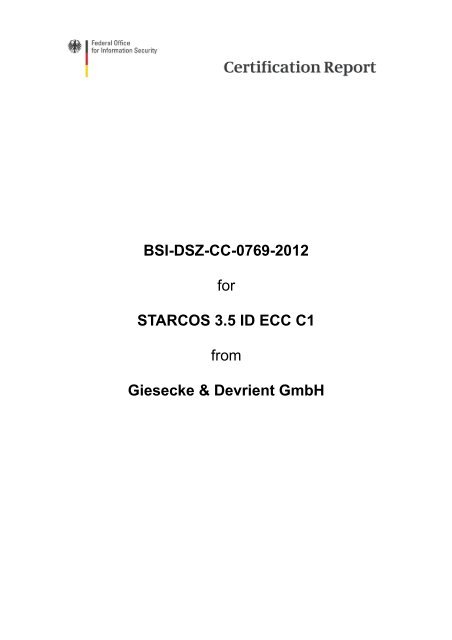
![[ST] System z10 EC LPAR Security Target V7.7.2 20081023 PU-205](https://img.yumpu.com/16227170/1/184x260/st-system-z10-ec-lpar-security-target-v772-20081023-pu-205.jpg?quality=85)
